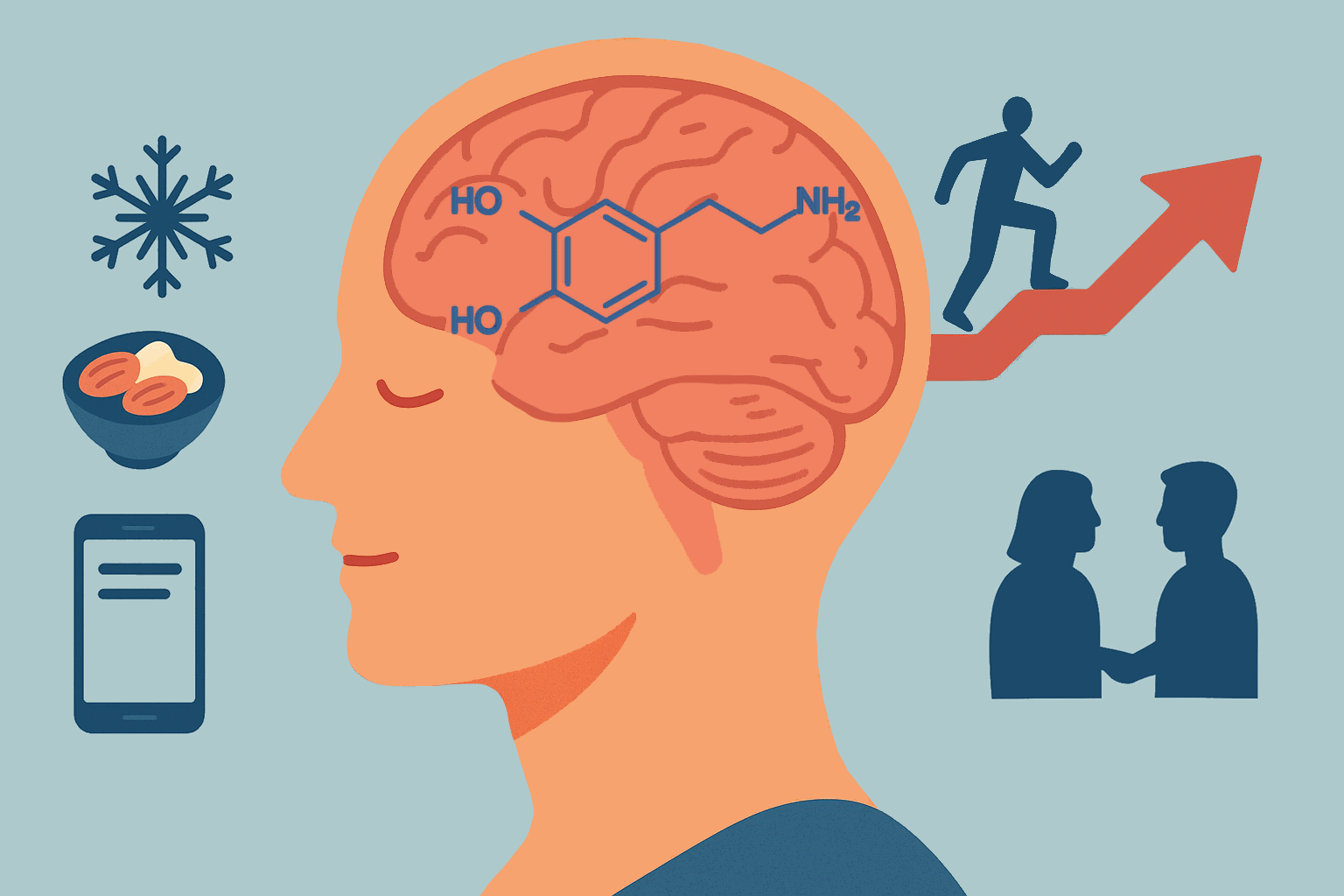
Short Videos & Your Brain: The Hidden Impact
- Olivia Hart
- Digital health , Mental wellness , Neuroscience
- June 14, 2025
Table of Contents
Fast Facts: Short Videos & Your Brain (TL;DR)
- Attention Disruption: Excessive use of short-video apps is linked to a shorter attention span and difficulty with sustained focus due to the brain adapting to rapid, fragmented content. [1], [2]
- Dopamine Loop: The endless, algorithm-driven feed of novel content creates a dopamine reward cycle in the brain, which can lead to addictive behavior and difficulty disengaging. [3]
- Emotional Impact: Constant exposure to emotionally charged videos can heighten anxiety, stress, and mood swings, challenging your brain’s ability to regulate emotions effectively. [4], [5]
- Productivity Loss: Interruptions from short videos significantly impair task completion and memory, leading to more errors and reduced productivity in work and academic settings. [6], [7]
- Reclaiming Control is Possible: Mindfulness, setting app timers, and taking structured digital breaks can help mitigate the negative effects and improve cognitive control. [8]
Introduction: The Unseen Cost of a Quick Scroll
In the spaces between tasks—waiting for coffee, riding the elevator, or winding down before bed—millions of us turn to the vibrant, endless stream of short-form videos on platforms like TikTok, Instagram Reels, and YouTube Shorts. While seemingly harmless, this habit is having a profound and measurable impact on our brain’s structure and function.
This article delves into the science behind how short video consumption affects your attention, memory, and emotional health. Grounded in neuroimaging research and psychological studies, we’ll explore the concept of “TikTok Brain,” analyze its cognitive consequences, and provide evidence-based strategies to help you reclaim your focus and build a healthier relationship with digital media.
The Science of TikTok Brain: How Short Videos Rewire Neural Circuits
The addictive nature of short videos isn’t a design flaw; it’s a feature. These platforms use sophisticated algorithms to deliver a hyper-personalized, never-ending feed of content that triggers the brain’s reward system.
At the heart of this is dopamine, a neurotransmitter associated with pleasure and motivation. Each novel, entertaining, or emotionally charged video acts as a small “hit” of dopamine. This creates a powerful feedback loop that keeps you scrolling. [3] Neuroimaging studies using fMRI have shown that viewing short videos activates brain regions tied to reward and addiction, such as the Ventral Tegmental Area (VTA) and substantia nigra. [3]
This constant stimulation comes at a cost. It can lead to the suppression of higher-order cortical areas like the dorsolateral prefrontal cortex (DLPFC), which is crucial for executive functions—the mental skills that include sustained attention, impulse control, and decision-making. [9] Over time, the brain starts to prefer rapid, high-stimulation rewards over activities that require deep, prolonged focus. This adaptation is what many now call “TikTok Brain.”
Cognitive Fallout: The Impact on Attention, Memory, and Focus
One of the most significant concerns is the erosion of our ability to maintain sustained attention.
Fragmented Focus: The rapid-fire pace of short videos trains the brain to switch contexts constantly. Research using EEG technology has demonstrated that individuals with a higher tendency for short-video addiction show lower levels of attentional focus, have shorter gaze durations, and make more errors on tasks requiring concentration. [1] This habit of “continuous partial attention” carries over into the real world, making it harder to focus on a single task like reading a book, completing a work assignment, or even holding a long conversation.
Impaired Memory: Effective memory consolidation requires the brain to encode information without interruption. The constant switching between videos disrupts this crucial encoding process in the hippocampus. [5] Furthermore, studies on prospective memory—the ability to remember and complete a future task—show a drastic decline in performance after an interruption by TikTok. Participants’ accuracy dropped to near-random levels, highlighting how these apps degrade our capacity to follow through on intentions. [6]
Reduced Task Efficiency: In work and academic settings, the consequences are clear. Interruptions from notifications and the pull of social media don’t just consume time; they also increase error rates and degrade the quality of work. [7] A study on Chinese undergraduates found that addiction to short-form video apps was a significant predictor of higher academic anxiety and lower academic engagement. [4]
The Emotional Rollercoaster: Short Videos and Mood Regulation
The impact isn’t purely cognitive. The endless stream of algorithmically curated content can send our emotions on a wild ride. Research shows that exposure to polarized content—rapidly switching1 between positive and negative videos—causes distinct and abrupt shifts in brain activity related to mood. [5]
This emotional volatility can exacerbate stress and anxiety. [4] When the brain becomes accustomed to the intense highs and lows of a video feed, it can struggle to regulate emotions in response to everyday, real-world stressors. The very platforms that people turn to for a moment of relaxation can inadvertently contribute to a cycle of emotional dysregulation.
Reclaiming Your Focus: Practical, Science-Backed Strategies

While the evidence is concerning, it’s not a life sentence. The brain’s neuroplasticity means you can retrain your attention and mitigate these negative effects.
Practice Mindfulness: Mindfulness is the practice of paying attention to the present moment without judgment. It has been shown to strengthen the prefrontal cortex and improve attentional control. [8] Simple exercises like focusing on your breath for a few minutes can help counteract the brain’s craving for constant external stimulation.
Set Firm Boundaries: Use app timers and phone settings to your advantage. Schedule specific, limited blocks of time for social media and turn off non-essential notifications, especially during work or study periods. Creating “tech-free” zones or times, such as during meals or the first hour of the day, can also be highly effective. [7]
Embrace ‘Deep Work’: Actively choose activities that require sustained, uninterrupted focus. This could include reading a physical book, learning a musical instrument, solving a complex puzzle, or hiking. These activities build your “attention muscle” in a way that passive scrolling cannot.
Take Control of Autoplay: The autoplay feature is designed to keep you watching. [15] A study from Penn State found that when users had manual control over autoplay, they were more aware of their consumption patterns and less likely to fall into a “rabbit hole.” [15] Whenever possible, turn this feature off to make your viewing more intentional.
Conclusion: Toward a Balanced Digital Diet
Short-form video platforms are a powerful and permanent fixture in our digital landscape. They offer connection, education, and entertainment, and some studies even suggest that certain types of digital engagement can lower the risk of cognitive impairment in older adults. [12]
However, the current design of these platforms, optimized for engagement above all else, poses real risks to our cognitive and emotional well-being. The key is not total avoidance but mindful, intentional engagement. By understanding the neuroscience at play and implementing practical strategies to maintain control, we can enjoy the benefits of these tools without sacrificing our ability to think deeply, focus intently, and live a balanced, productive life.
Frequently Asked Questions (Q&A)
Q1: What is `TikTok Brain` and is it a real diagnosis?
TikTok Brain is a colloquial term, not a formal medical diagnosis. It describes the collection of cognitive and psychological patterns seen in heavy users of short-form video apps, including a reduced attention span, a craving for constant stimulation, and impaired executive function. The phenomenon is supported by neuroimaging studies showing changes in brain regions related to reward and attention. [1], [3]Q2: How much short-form video is considered too much?
Q3: Can I reverse the effects of short videos on my attention span?
Q4: Are there any benefits to watching short videos?
Disclaimer
The information provided on BioBrain is intended for educational purposes only and is grounded in science, common sense, and evidence-based medicine. It is not a substitute for professional medical advice, diagnosis, or treatment. Always consult a qualified healthcare provider before making significant changes to your diet, exercise routine, or overall health plan.
References
- Chen, Z., et al. (2023) "Mobile phone short video use negatively impacts attention functions: An EEG study based on the attention network test"
- Mohd Asif & Saniya Kazi (2024) "Examining the Influence of Short Videos on Attention Span and its Relationship with Academic Performance"
- Su, C., et al. (2025) "Neuroanatomical and functional substrates of the short video addiction"
- Chen, Q., et al. (2023) "Effects of short-form video app addiction on academic anxiety and academic engagement among Chinese undergraduates"
- Wang, Y., et al. (2025) "EEG reveals the cognitive impact of polarized content in short video on emotional states and encoding processes"
- Chiossi, F., et al. (2023) "Short-Form Videos Degrade Our Capacity to Retain Intentions: Effect of Context-Switching On Prospective Memory"
- Stothart, C., et al. (2015) "The Attentional Cost of Receiving a Cell Phone Notification"
- Hölzel, B. K., et al. (2011) "How does mindfulness meditation work? Proposing mechanisms of action from a conceptual and neural perspective"
- Gao, L., et al. (2024) "Interdisciplinary Insights into Short Video Addiction: Neurobiological Mechanisms, Behavioral Risks, and Intervention Strategies"
- Brooks, S. K., et al. (2020) "The psychological impact of quarantine and how to reduce it: rapid review of the evidence"
- Ye, Z., et al. (2024) "Loss Aversion and Evidence Accumulation in Short-Video Addiction: A Drift Diffusion Model"
- Lee, S., et al. (2025) "Digital Dementia: Does Technology Use by ‘Digital Pioneers’ Correlate with Cognitive Decline?"
- Maryville University "Psychology of Social Media: Why We Feel the Need to Share"
- Radesky, J., & Christakis, D. (2016) "Increased Screen Time: Implications for Early Childhood Development and Behavior"
- Penn State (2023) "User control of autoplay can alter awareness of online video 'rabbit holes'"
Tags :
- Short videos
- Tiktok brain
- Attention span
- Cognitive health
- Digital wellness
- Neuroscience
- Emotional regulation
- Screen time
- Brain function
- How to improve focus
